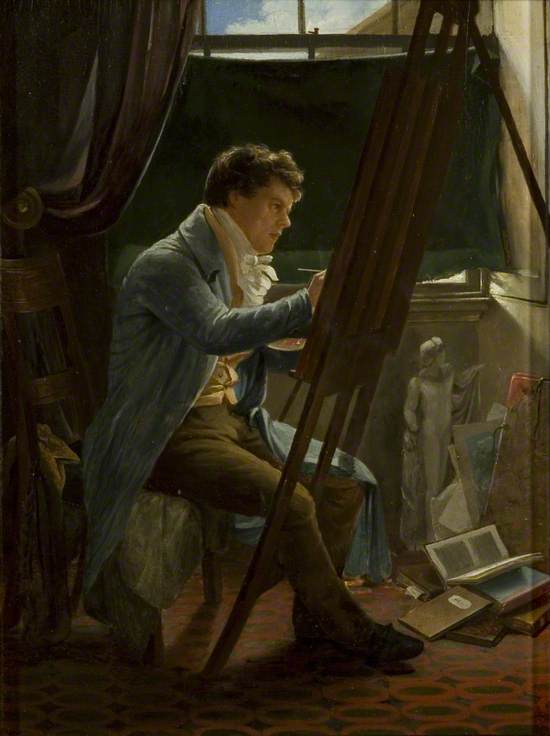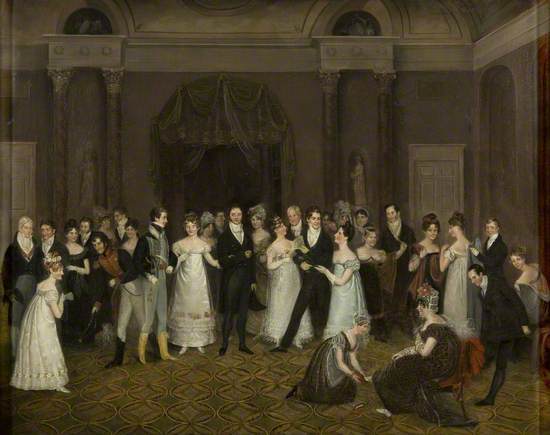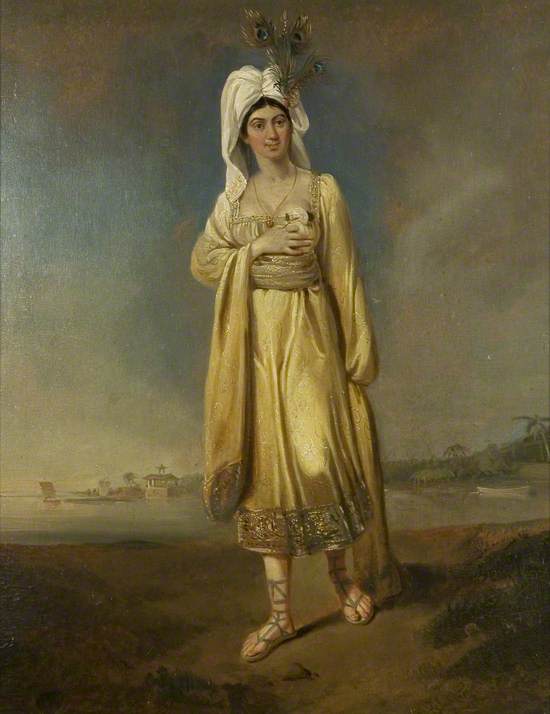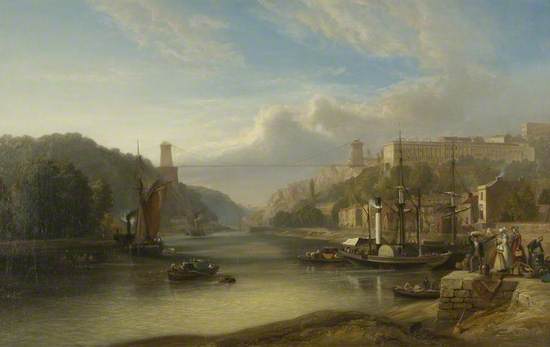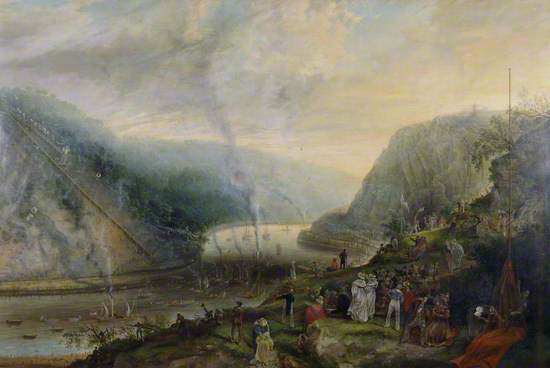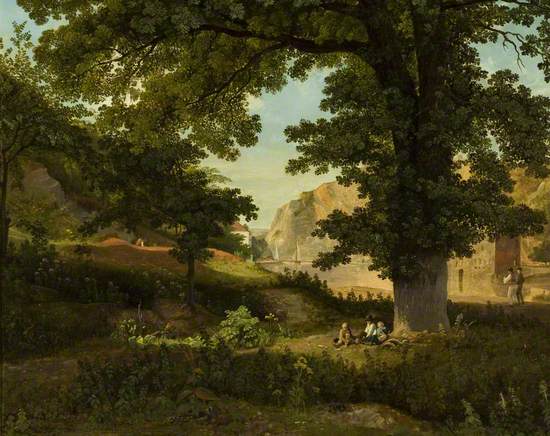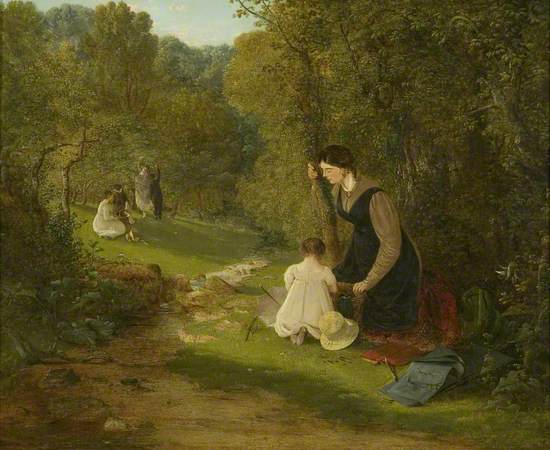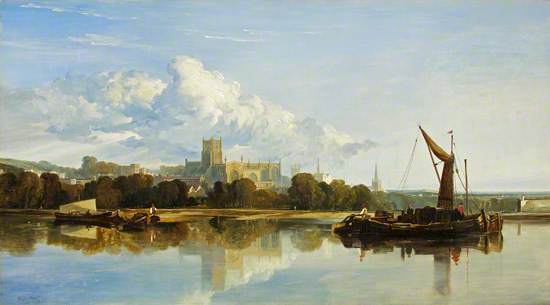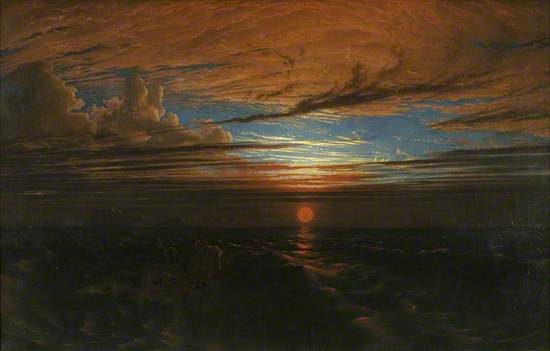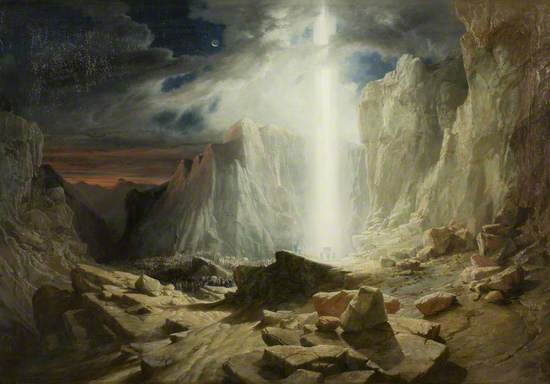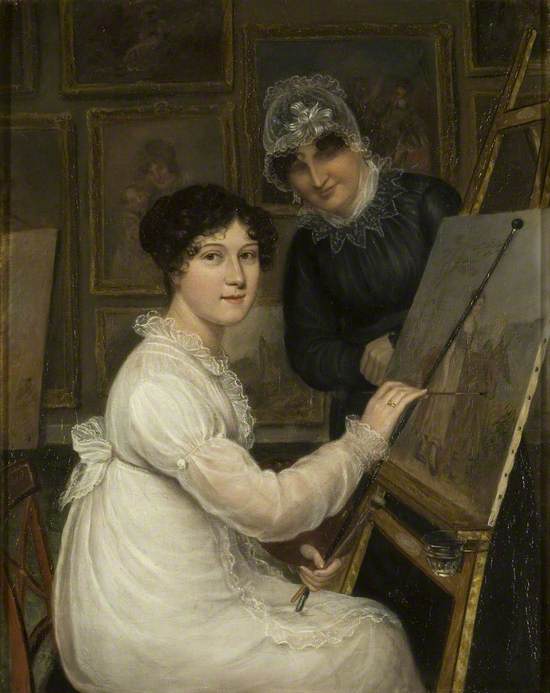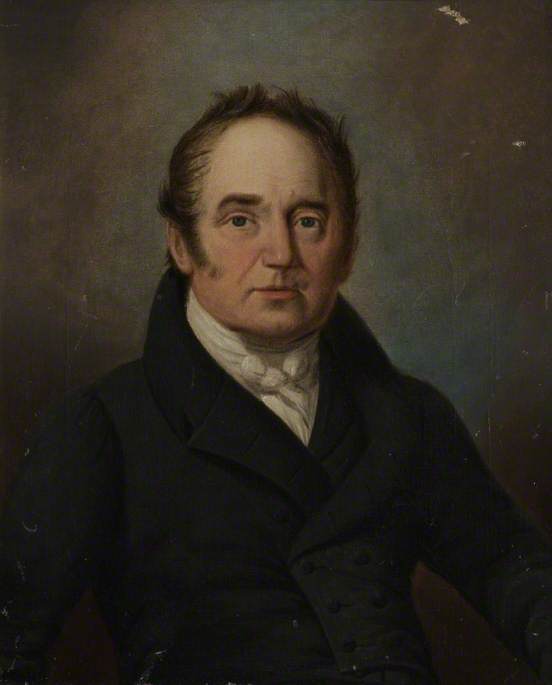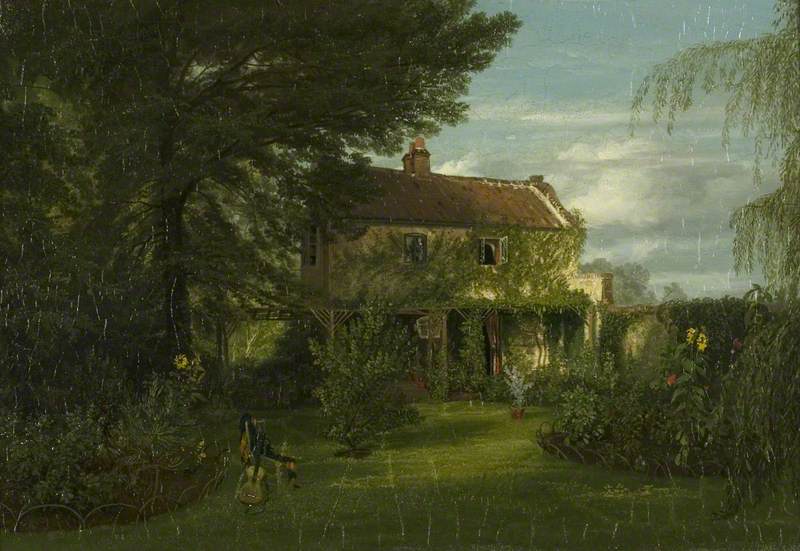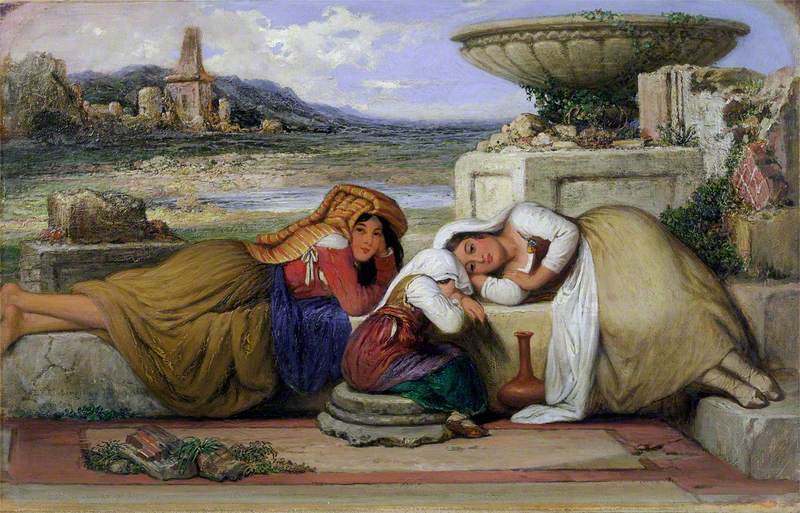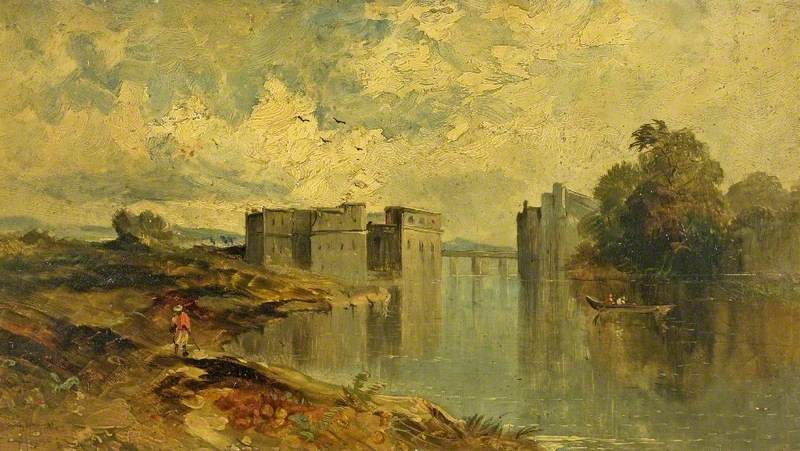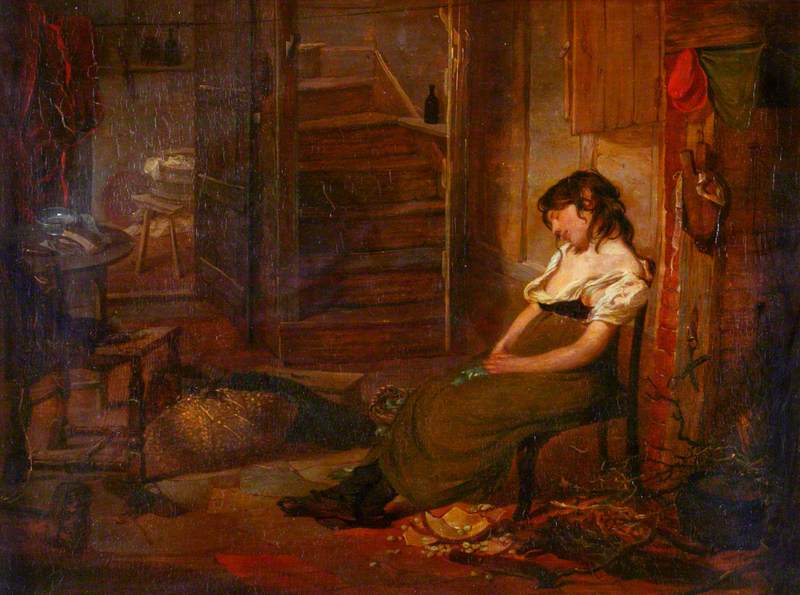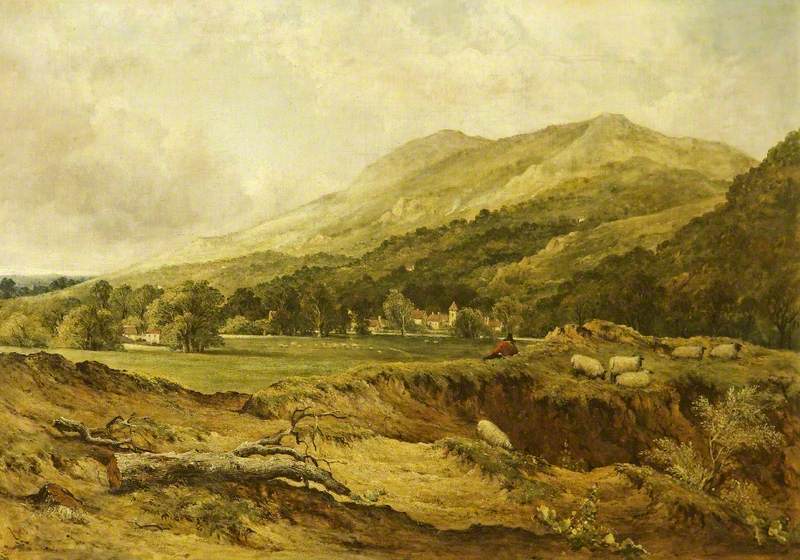During the early 19th century Bristol witnessed a period of unique creativity. From about 1810, artists who moved to this historic global port on the river Avon encountered a stimulating intellectual climate, urban life and striking natural settings which in turn inspired and favoured their distinct contribution to British art. Yet today artists like Edward Bird, Francis Danby or Rolinda Sharples are not well known among British or international audiences. To put this right, the Musée des Beaux-Arts in Bordeaux was to open an exhibition of works by Bristol School artist this May - with support from the Louvre and most of the loans coming from Bristol Museum & Art Gallery. The opening had to be postponed, but here are my highlights.
Bristol the Port City
Müller shows us a panoramic view of Bristol with its 'Floating Harbour'. The painting is rather romanticised in its depiction of the industrialised city which artists like him, Bird, Rippingille, Danby, Jackson and Sharples as well as many others made their base during the early 19th century. Since the Middle Ages Bristol had been a thriving port safely situated 13 km inland from the Severn Estuary. Trade with Europe and the wider world had made it the 2nd richest city in England after London, a status it wouldn’t lose until the late 18th century. But since the end of the 17th century Bristol’s merchants had become directly involved in the transatlantic slave trade and owned Caribbean sugar plantations worked by enslaved Africans.
William James Müller (1812–1845)
Oil on canvas
H 91.4 x W 172.7 cm
Bristol Museums, Galleries & Archives
Artists coming together in Bristol
The "Bristol School" were a group of professionals and amateurs held together through friendship and shared artistic activity, rather than an institutional framework. Many had moved to the city from elsewhere and it now provided them with the scientific, religious, cultural and aesthetic ideas and motifs, with the patrons, dealers and exhibition spaces that fostered their art. Here we see Edward Bird, who can be credited with bringing the group together through his "sketching parties", seated at the easel in his studio surrounded by books. Bird was Bristol’s first Royal Academician and became historical painter to Princess Charlotte. He actually trained as a japanning artist, decorating lacquered, tin-plate domestic items such as trays.
Edward Villiers Rippingille (1798–1859)
Oil on mahogany panel
H 34.2 x W 26.1 cm
Bristol Museums, Galleries & Archives
Social Genre Painting
A fresh, unsentimental and frequently political approach to genre painting is one of the legacies of the Bristol School. This scene is set in a local village, probably Long Ashton near Bristol. Crowds have gathered around a dashing recruiting sergeant tempting a gullible young man to enlist in the army. In the central background the slopes of the open countryside can be seen, but the buildings and figures make it impossible for the shy-looking young man to escape the persuasive blandishments of the sergeant. The sergeant appears to offer glory, rank and wealth, but the true outcome for the ordinary soldier, demobbed after the Napoleonic wars, is shown on the far right behind a tree, where a forlorn veteran approaches a cottage for alms.
Edward Villiers Rippingille (1798–1859)
Oil on mahogony panel
H 83.4 x W 135.9 cm
Bristol Museums, Galleries & Archives
St James's Fair - rowdy Bristol
St. James's Fair had taken place in Bristol since the 13th century, but by the 1820s it was notorious for the crime and general debauchery it attracted. This brightly-coloured image is built on the contrast of morally sound and reprehensible behaviour in a cornucopia of intertwined action. The smart house on the left and the well-ordered book, globes and antiques stall in front of it could not differ more from the run-down brothel on the right. In between the crowds are enjoying themselves at the fair. As in other works by the Non-conformist Colman there is an undercurrent abolitionist sentiment: the pamplets available on the stall include Hannah More's 'Slavery, a Poem' and Colman's own painting 'St John Preaching in the Wilderness'.
Samuel Colman (1780–1845)
Oil on panel
H 87.6 x W 133.9 cm
Bristol Museums, Galleries & Archives
Clifton Assembly Rooms - genteel Bristol
The Clifton Assembly Rooms were designed by Francis H. Greenway (1777-1837) and opened in 1811 as a hotel. For a female artist this more genteel venue of Bristol life was probably seen as a more appropriate subject than St James's Fair. Rolinda Sharples chose a ball at the venue for her first multi-figure oil painting, showing ladies and gentlemen arriving for the exclusive and presumably highly-anticipated society event. Sharples came from a family of portrait artists and spent much time in the United States. She was one of the first female painters to become a (honorary) member of the Society of British Artists and tried her hand at a wide range of genre painting, including portraits, and religious paintings and landscapes.
Rolinda Sharples (1793–1838)
Oil on canvas
H 73 x W 88.2 cm
Bristol Museums, Galleries & Archives
Princess Caraboo
Bristol School artists also witnessed the scandals of the early 19th century city. In this small painting Edward Bird depicted an elegant young woman in a white turban with peacock feathers and a flowing yellow silk dress, before a imaginary landscape with Indian temples and palm trees. She engages the viewer with her direct gaze and open smile. Before her final sitting with Bird, 'Princess Caraboo of Javasu', as she had been introduced to Bristol society, was exposed as Mary Baker, the daughter of a Devonshire cobbler. It is remarkable that Baker spun such a yarn, but even more telling that the public wanted to believe the exoticising story of a helpless foreigner captured by pirates, showcasing colonial attitudes to non-Europeans.
Edward Bird (1772–1819)
Oil on panel
H 38.1 x W 30.5 cm
Bristol Museums, Galleries & Archives
An iconic Landscape - a changing Cityscape
The Bristol School’s numerous local landscape paintings captured the natural surroundings of the city most atmospherically during the first decades of the 19th-century – and successfully canonised for the first time the very beauty spots which still define any visual representation of Bristol’s environment today. This is especially true for the Avon Gorge, the dramatic geological feature, where the local river Avon cuts deeply through a limestone ridge on its way to the sea, and which, crowned by the Clifton Suspension Bridge, is now Bristol’s most recognisable and commercially viable landmark. When Jackson painted this image the bridge had not actually been completed.
Samuel Jackson (1794–1869)
Oil on canvas
H 62.9 x W 101.6 cm
Bristol Museums, Galleries & Archives
Developing the natural Landscape
Bristol and its surrounding countryside continued to be radically industrialised and developed during the early 19th century. Colman's painting conveys the popular enthusiasm for as well as the concerns over the great engineering projects of the day. Many of those present at the laying of the foundation stone would have appreciated the way the finished Clifton Suspension Bridge would complement or potentially threaten the dramatic natural scenery. In the painting, the artist has further emphasised its aesthetic impact, by reducing the scale of the steam ships and boats on the water below. The Avon appears much wider than it actually is rendering the scene more sublime.
Samuel Colman (1780–1845)
Oil on canvas
H 86 x W 128 cm
Bristol Museums, Galleries & Archives
Nature and Romanticism
Inspiration from nature gained on excursions beyond the city, especially during visits to the Avon Gorge, Leigh Woods and its celebrated Nightingale Valley on the river’s Somerset side, played a significant role in the formation of the Bristol School’s identity as a convivial group of creative men and a few women. But here Danby has replaced artists and guests to the Hotwells spa (who appear in other landscapes) with local children sitting under a majestic oak tree and workmen enjoying the tranquil summer day. Stylistically the work looks remarkably continental-European, but further research is needed into the awareness of Bristol School artists of Romantic art, especially in Germany and Denmark, at the time.
Francis Danby (1793–1861)
Oil on panel
H 40 x W 50.8 cm
Bristol Museums, Galleries & Archives
Creativity observed
Artists appear in many of the landscape paintings and we frequently see women producing art - as in this image by James Johnson. The young woman in the right foreground has put down her sketchbook to help the child next to her with her basket. It reveals expressive studies of trees. Women in Bristol acquired their artistic training differently to men, both to the professionals and the amateurs which belonged to the Bristol School. Girls were encouraged to learn to draw, especially landscapes. But - with the exception of Rolinda Sharples - they were not expected to be trained professionally or make a living from art. Yet albums collated by local woman such as Mary Carpenter tell us how they learned from copying and exchanging watercolours.
James Johnson (1803–1834)
Oil on mahogany panel
H 40.3 x W 50.8 cm
Bristol Museums, Galleries & Archives
No Change, please
In the landscapes and topographical views of the city, Bristol School artists would have struggled to overlook the accelerated social and physical change Bristol and its environment were undergoing. But in this painting William James Müller set out to create an ideal image of timeless beauty according to the aesthetic rules of the Picturesque, a way of looking at art and nature – where nothing threatens to disturb the careful balance of the picture. This would have appealled to patrons: e.g.George Weare Braikenridge, a West India merchant who received state compensation after slavery was abolished in 1833, comissioned over 1400 topographical drawings and watercolours to record Bristol's streets and monuments in this sanitised way.
William James Müller (1812–1845)
Oil on canvas
H 75.2 x W 135.6 cm
Bristol Museums, Galleries & Archives
All Change
4 years earlier Müller had produced vivid oil sketches of the violent Bristol Riots, which had erupted over the House of Lords’ rejection of the Reform Bill. Müller had observed the events first-hand and his images seem to betray some sympathy with the rioters and a huge fascination with the chaos caused by fires and destruction across the city; something which makes the presumably commissioned View of Bristol Cathedral (above) even more deliberate in its stability. This image capitalises on the dramatic contrast of a dark, cloudy night-time sky and the intense yellow, orange and red colours of the fire. The flames are portrayed as an elemental force, burning so high they can be seen from a great distance, overturning the status quo.
William James Müller (1812–1845)
Oil on paper
H 8.8 x W 17.6 cm
Bristol Museums, Galleries & Archives
Ambition beyond Bristol - Foreign shores
Bristol School artists have been presented as the illustrators of the city where they first came together, but many of them had ambitions that went further afield - in subject matter, professional success and simply geographically.
Müller was to leave Bristol to travel extensively on the European continent and in the Middle East seeking artistic inspiration, and he also spent time in London like others of the group before him. Müller stated ‘I must paint to live – well then I paint one picture for the world & money – also will I paint one for myself. Let that one be for Eternity’.
This is his vibrant Carpet Bazaar in Cairo, in which he revelled in colour and light.
William James Müller (1812–1845)
Oil on panel
H 62.2 x W 74.9 cm
Bristol Museums, Galleries & Archives
Ambition beyond Bristol - Sublime Subjects
Francis Danby's sublime "Sunset at Sea" was first exhibited at the newly opened Bristol Institution for the Advancement of Science, Literature and the Arts and then at the Royal Academy, the fourth painting by Danby to be shown in London. It was a great success and made the artist’s reputation. Those influenced by the painting included Turner and John Martin. The picture was purchased by the Bristol-born President of the Royal Academy, Thomas Lawrence. A blood-red sun is setting over a vast expanse of rolling waves in the aftermath of a storm. It eerily illuminates the streaks of clouds lingering in the sky above. On the horizon hostile cliffs can be seen, which offer little hope for the shipwrecked mariners clinging on to a small raft.
Francis Danby (1793–1861)
Oil on canvas
H 89.6 x W 142.9 cm
Bristol Museums, Galleries & Archives
Biblical subjects and scientific interests
The religious story of this paintings is amplified by the magnificence and sublimity of the natural setting, but the almost hyper-realistic rock formations also reflect West’s and the other Bristol artists’ scientific interest in geology, which had developed into an academic discipline during the early 19th century. Much of this engagement happened at the Bristol Institution for the Advancement of Science, Literature and the Arts where the father of West’s fellow artist William James Müller, the eminent geologist Johann Samuel Müller, worked as its first curator. West himself was also interested in engineering and early photography and had an observatory and camera obscura built in Bristol which can still be visited.
William West (b.c.1793–1861)
Oil on canvas
H 111.7 x W 167.6 cm
Bristol Museums, Galleries & Archives
Rediscovering the Bristol School
The Bristol School are part of a wider British and European art history, something that the collaboration with our colleagues in Bordeaux and future research and redisplay will continue to promote. Rolinda Sharples is looking out of her painting and inviting us to get to know her and her fellow artists better.
Rolinda Sharples (1793–1838)
Oil on panel
H 36.8 x W 29.2 cm
Bristol Museums, Galleries & Archives

